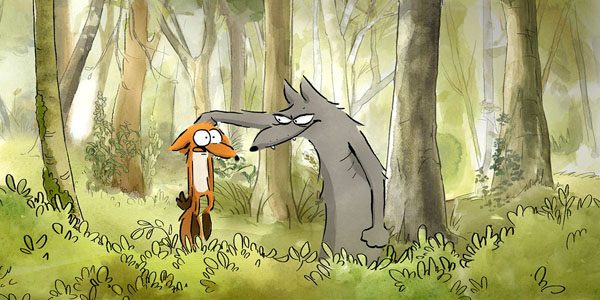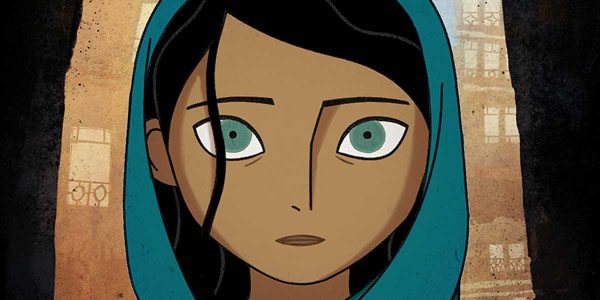2018 School Spending Survey Report
'The Big Bad Fox' and 'The Breadwinner' Movies Premiere
Two book-to-screen adaptations recently premiered at the Toronto International Film Festival.

Fox and Wolf in The Big Bad Fox and Other Tales (TIFF)
A self-effacing, bushy-tailed, accidental vegetarian was one of the scene-stealers at the recent Toronto International Film Festival. The hapless hero of the spry and light-on-its feet The Big Bad Fox and Other Tales was among the liveliest crowd-pleasers at the event, and one of two animated movies based on kids' books that premiered there. French filmmaker Benjamin Renner, the author of the comic strip–turned–graphic novel The Big Bad Fox, and his codirector, Patrick Imbert, previously made Ernest & Celestine, which was nominated for the Best Animated Feature Academy Award in 2014. (SLJ called it a “sweet story, with subtle but beautiful watercolor animation.”) That movie was distributed in the United States by GKIDS, which will also be releasing the new film in 2018, presumably with a dubbed, English-language voice cast. In a compact 80 minutes, the barnyard animals of Honeysuckle Farm put on three short plays for viewers, emceed by a nervous red fox. The movie’s centerpiece, and longest, segment is the presentation of “The Big Bad Fox,” based on the book which received an SLJ starred review: “it’s sure to tickle young funny bones, and the author injects the narrative with a sly, edgy sensibility that sets this title apart from more typical fare.” Likewise, the hand-drawn animated film version retains the same spirit, with madcap, slapstick humor that will appeal to kids and adults. The filmmakers set the earthy, pastel colors against a soft white background—lovely lunacy, faithful to the source material. Like Rodney Dangerfield before him, the red fox can’t get any respect; he’s chased out of a henhouse by an imperious mother hen, and even a butterfly mocks his attempt at aggressive preening. If it weren’t for the generous offering of turnips by an officious pig, the hapless carnivore would have nothing to eat. Goaded on by a wolf, Fox steals Hen’s eggs to later fatten up the hatched chicks before swallowing them whole. However, he’s the first creature that the newborns see. The three of them chirp, maman, follow Fox everywhere, play jump rope with his long tail, and beg to sleep with him, in fear of the notorious big bad fox. After a lot error and error, Fox finally convinces the chickadees that he is, indeed, the fox of their nightmares. Their reaction: “So we are foxes, too!” Now they also want to gobble on helpless chicks. The most Looney Tunes–esque vignette is the opening segment, “The Baby Delivery,” where the on-the-ball Pig and a more perplexed Bunny and Duck take over for an injured Stork to deliver a baby girl to the proper address near Avignon. One of their ideas: to catapult the baby to its destination; another is to take over an airplane midair. In the concluding comedic caper, “Saving Christmas,” Bunny and a hound dog believe that they have recklessly killed Father Christmas, so it’s up to them and Duck (who dons a red cap) to find a makeshift sleigh and presents and take flight as the replacement. All of the stories are heavy on hijinks and light on allegory, even when upturning traditional (and gender) roles in “The Big Bad Fox.” Taking its rhythms from New Orleans jazz, the score by Robert Marcel Lepage keeps the pace bouncing along even higher than the bouncing baby. The silly and sweet movie will send kids to the book, whether they are comic book fans or reluctant readers.
Parvana in The Breadwinner (TIFF)
Part history lesson, part war film, and all coming-of-age, the page-to-screen transfer of Deborah Ellis’s 2000 prescient novel The Breadwinner arrived with the typical give-and-take between original material and its arrival on the screen. Some of the themes and subplot are appropriately highlighted and expanded upon on screen, while one specific addition feels like padding. (The “screen story” is credited to Ellis.) Set during the hard-line Taliban rule in Afghanistan shortly before the U.S. invasion, hazel-eyed Parvana, 11, lives in a single room with her parents and two siblings (down one from the book), where her father keeps hidden a stash of English books under the floorboards. Out in the hustle-bustle streets of Kabul, she aids her father, who lost a leg during the Soviet occupation, to his spot in the marketplace. He sells off household items and reads letter for the illiterate to eke out enough money to buy rice and raisins for dinner. (Already he has to fight off would-be older suitors to his daughter. He suavely deflects their curiosity, saying she is already promised.) While the family has gathered around on the floor to eat in the evening, Taliban soldiers kick in the door and within seconds steal him away. The family has no idea why he was taken or when, or if, he will be freed. Among the restrictions imposed by the Taliban is that women are forbidden to venture on their own without a male guardian, even to the market. Unlike in the book, preteen Parvana on her own decides she should take the initiative to cut off her long hair and to wear the clothes of her older brother, who was killed years earlier by a land mine. She takes on the persona of a boy in order to earn money—and food—for the family, since her older sister isn’t physically able to pull of this masquerade and her only brother is just a toddler. To comfort her scared brother, Parvana tells him the story of a young man on a quest to rid his village of the Elephant King’s curse. In these cut-out animated sequences, the palette changes and bedazzles, jumping off the screening. Presumably, this extended section answers the question of why the filmmakers chose animation, as opposed to the live-action format, to depict the story—and maybe to make the narrative more kid-friendly. Yet the warrior’s quest is a digression from the gritty and rather bleak overarching story line. Though the time and place of the movie is dramatic, and then some, the loose and expanded narrative is not so much, and deflates some of the tension. Strangely, one of the father’s tales that is not mentioned onscreen, unlike in Ellis's book, is the legend of the young female warrior Malalai (or Malali), who stood up against the British Army in the 19th century, preventing Britain from claiming Afghanistan as part of its empire. It's the one Afghani tale that young viewers are likely to know. (The documentary He Named Me Malala, on Nobel Peace Prize winner Malala Yousafzai, included an animated sequence about Malalai, for whom the real-life activist was named for, perhaps stealing The Breadwinner’s thunder.) As a result, instead of a girl leading by example, a boy becomes Parvana’s inspiring role model. The atmospheric, panoramic, and earth-toned backgrounds add a specificity to the otherwise flat expressions of much of the animation. The most fluid movement in the film might be Parvana's mother’s bellowing blue burqa—which she resents having to wear in public. In depicting the landscape, the film resorts to photo realism; a red desert becomes a graveyard for stranded tanks. As directed by Nora Twomey (The Secret of Kells), the film refrains from depicting the more violent actions of the Taliban without sanitizing Ellis’s work, though it downplays the more graphic or potentially macabre sequences from the text, such as when Parvana works as a gravedigger (she earns more money for bones than selling wares in the marketplace). In another departure from the source material, the movie stands alone; the book kicked off a trilogy, though leaving the characters, and readers, in limbo. The Breadwinner will, too, be distributed in the United States by GKIDS in 2018. Though the film's strongest appeal is for readers of the series and animation fans, it might receive further attention because of one of its executive producers, Angelina Jolie.RELATED
RECOMMENDED
CAREERS
The job outlook in 2030: Librarians will be in demand
CAREERS
The job outlook in 2030: Librarians will be in demand
ALREADY A SUBSCRIBER? LOG IN
We are currently offering this content for free. Sign up now to activate your personal profile, where you can save articles for future viewing






Add Comment :-
Be the first reader to comment.
Comment Policy:
Comment should not be empty !!!